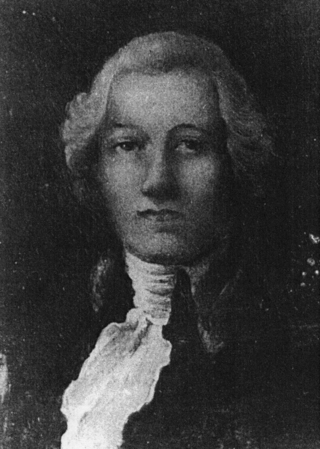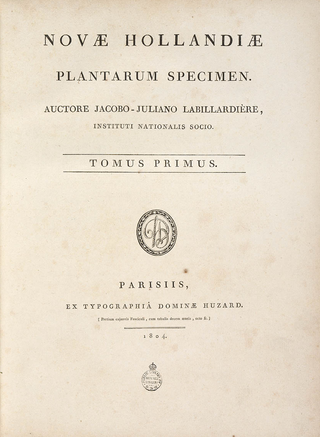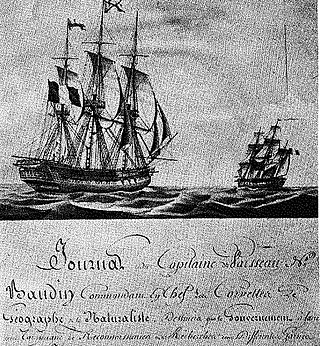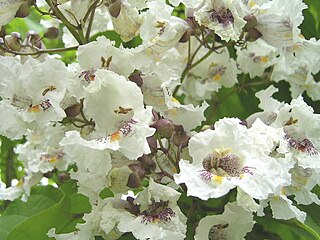
Louis Claude de Saulces de Freycinet was a French Navy officer. He circumnavigated the earth, and in 1811 published the first map to show a full outline of the coastline of Australia.

Nicolas Thomas Baudin was a French explorer, cartographer, naturalist and hydrographer, most notable for his explorations in Australia and the southern Pacific.

Jean-Baptiste Louis Claude Théodore Leschenault de La Tour was a French botanist and ornithologist.

Luis Née was a French-born Spanish botanist and prolific collector of plant specimens who accompanied the Malaspina Expedition on its five-year scientific exploration of the Pacific Ocean and surrounding lands. In addition to his botanical work he was a pharmacist with a keen interest in medicinal plants and their applications.
The Baudin expedition of 1800 to 1803 was a French expedition to map the coast of New Holland. Nicolas Baudin was selected as leader in October 1800. The expedition started with two ships, Géographe, captained by Baudin, and Naturaliste captained by Jacques Hamelin, and was accompanied by nine zoologists and botanists, including Jean-Baptiste Leschenault de la Tour, François Péron and Charles-Alexandre Lesueur as well as the geographer Pierre Faure.

George Samuel Perrottet, also known as Georges Guerrard-Samuel Perrottet, Guerrard Samuel Perrottet, Gustave Samuel Perrotet [sic], and Samuel Perrottet, was a botanist and horticulturalist from Praz, in the commune of Vully-le-Bas, today Mont-Vully, canton Fribourg Switzerland. After expeditions in Africa and Southeast Asia where he collected plant and animal specimens, he worked in French Pondicherry, India, where he established a botanical garden. He took a special interest in plants of economic importance and was involved in the activities of acclimatisation societies in the various colonies of France. Many of his zoological specimens, sent to museums in France, were examined by other naturalists and named after him.

Géographe was a 20-gun Serpente-class corvette of the French Navy. She was named Uranie in 1797, and renamed Galatée in 1799, still on her building site. Her builder refused to launch her, as he had not been paid to that time. Finally launched in June 1800, she was renamed Géographe on 23 August 1800.

Naturaliste was one of the two-vessel Salamandre-class of galiotes à bombes of the French Navy. Under Jacques Hamelin, and together with Géographe she took part in the exploration of Australia of Nicolas Baudin.

Novae Hollandiae Plantarum Specimen is a two-volume work describing the flora of Australia. Facsimiles of the originals can be found in the online Biodiversity Heritage Library (Vol.1) and Vol 2).

Antoine Guichenot or Guichenault (1783–1867) was "gardener's boy" on the 1801—1804 French scientific voyage to Australia under Nicolas Baudin, and the 1817 voyage under Louis de Freycinet. Very little is known about him, but the records of Baudin's voyage, together with annotations on surviving plant specimens collected by him, suggest that he was poorly educated, with atrocious spelling and little knowledge of botany, yet worked extremely hard, collecting more plant specimens than the officially appointed botanist, Jean Baptiste Leschenault de la Tour, and, despite his poor literacy, labelling them with much more useful annotations. There were five gardeners altogether on the Baudin voyage, the others being Antoine Sautier, François Cagnet and Merlot, all under the supervision of Head Gardener Anselme Riedlé.

Félix Delahaye was a French gardener who served on the Bruni d'Entrecasteaux voyage (1791–93) that was sent by the French National Assembly to search for the missing explorer Jean-François La Perouse. He was also one of the earliest European gardeners to work in Australia.
Jean Nicolas Collignon (1762–?1788) was a gardener and botanist from the Jardin du Roi who served on the La Pérouse expedition to the South Seas (1785–?1788).
Antoine Sautier was a student gardener who was invited to join the Baudin scientific expedition (1800–1804) in the corvettes Géographe and Naturaliste to chart the coast of New Holland (Australia), make scientific observations and collect natural history specimens. This was the grandest such voyage of its kind in the early nineteenth century with a team of 22 savants. He was a member of a team of 5 gardeners that served on this voyage, the others being Antoine Guichenot, François Cagnet, and Merlot all under the supervision of Head Gardener Anselme Riedlé.

Anselme Riedlé (1765–1801) was gardener at the Jardin des Plantes who was invited to join the Nicolas Baudin scientific expedition (1800–1804) in the corvettes Géographe and Naturaliste to chart the coast of New Holland (Australia), make scientific observations and collect natural history specimens. This was possibly the largest such voyage of its kind in the early nineteenth century, with a team of 22 savants. He was Head Gardener to a team of 5 gardeners that served on the voyage, the others being Antoine Sautier, Cagnet, Merlot, and Antoine Guichenot. Riedlé had accompanied Baudin on a previous expedition where Riedlé had collected plants in the West Indies.

Pierre-Paul Saunier (1751–1818) was a gardener who worked first at Montbard in the Bourgogne region in eastern France, and then at the Jardin du Roi in Paris where he was a protégé of head gardener André Thouin (1746–1824). In 1785, Thouin selected him to accompany the explorer-botanist André Michaux (1746–1802) to North America where he was to assist in the establishment of a royal garden for the French crown.

Jean-Nicolas Céré was a French botanist and agronomist born on the Indian Ocean Isle de France but educated in Brittany and Paris. On the Isle de France he was befriended by Pierre Poivre (1719–1786), administrator of the Isle de France and Ile Bourbon (Réunion), who he assisted in the cultivation of spices. When Poivre was recalled to France in 1773 Céré was appointed Director of the Royal Garden at Monplaisir, a position he held from 1775 to the time of his death in 1810.

Franz Boos was an Austrian gardener-botanist in the Age of Enlightenment, a voyager and collector of natural history specimens for Emperor Joseph II of Austria, who reigned from 1765 to 1790.
Joseph Martin was an Enlightenment gardener-botanist and plant collector who worked at the Jardin du Roi in Paris. He was sent on collecting expeditions to the Isle de France, Madagascar, Cape and Caribbean.

Jean-François Cagnet, born in Baumont in 1756, was a French gardener who worked under the botanist André Michaux in the course of the Nicolas Baudin voyage of scientific discovery (1800–1804).

Botanical expeditions are scientific voyages designed to explore the flora of a particular region, either as a specific design or part of a larger expedition. A naturalist or botanist would be responsible for identification, description and collection of specimens. In some cases the plants might be collected by the person in the field, but described and named by a government sponsored scientist at a botanical garden or university. For example, species collected on the Lewis and Clark Expedition were described and named by Frederick Traugott Pursh.














